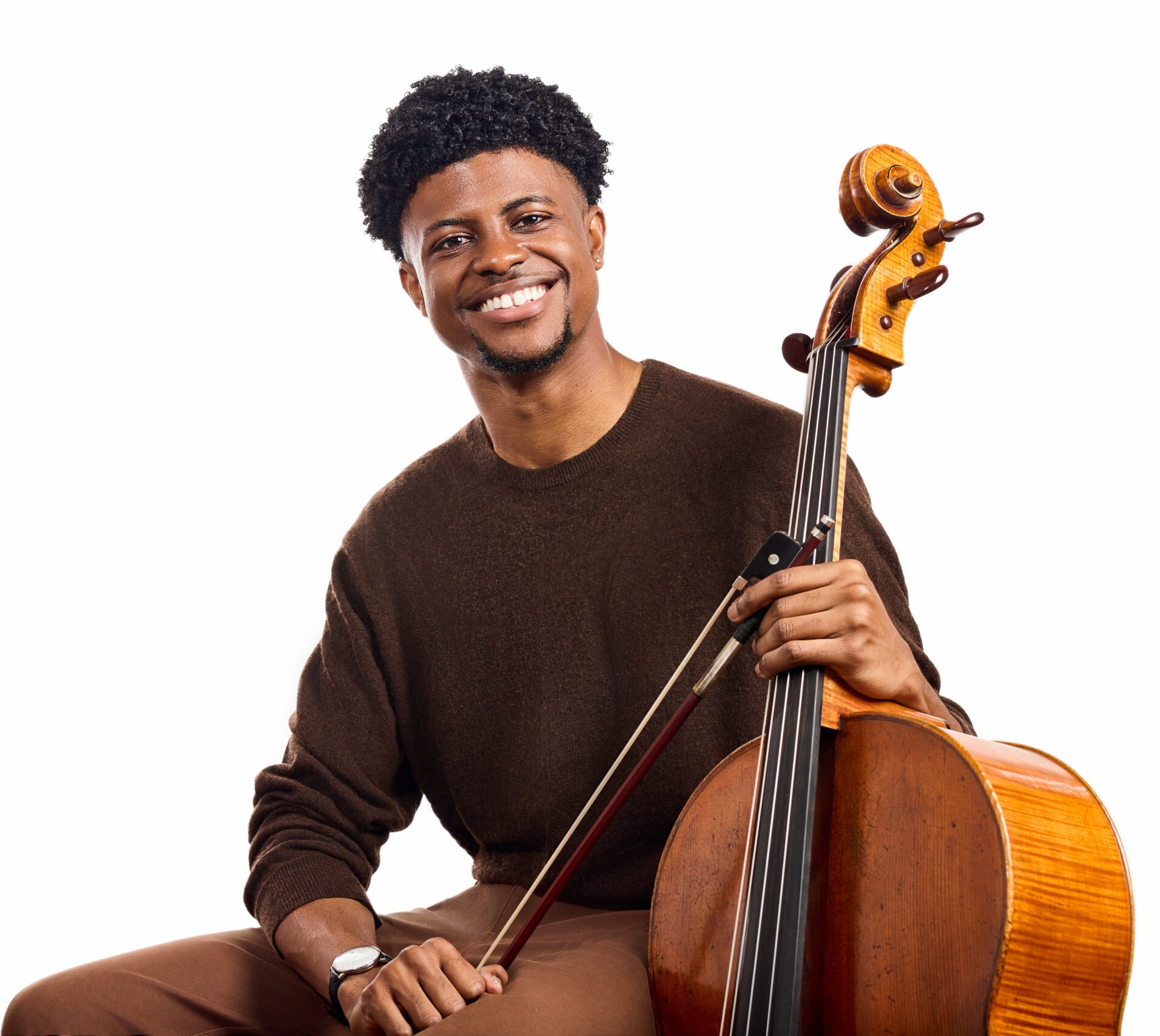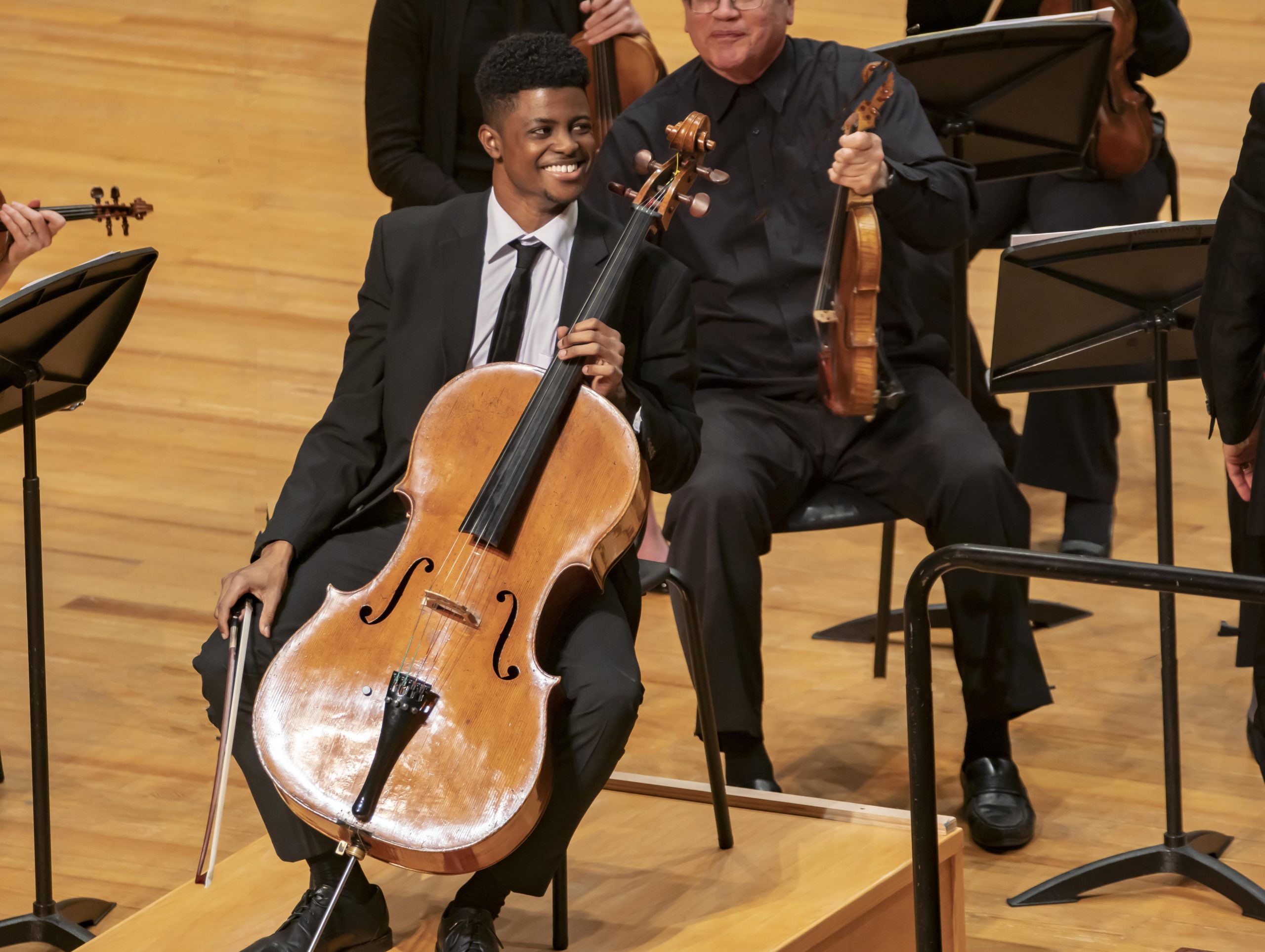People in the News
New Artist of the Month: Cellist Sterling Elliott
 Birth order is what initially led Sterling Elliott to the cello. His mother, Dannielle Weems-Elliott, began teaching his two older siblings at a young age, emulating the method she herself had learned as a Suzuki violin student. Sterling watched his brother and sister practice the violin and at first wanted to make it his instrument as well. But his mother encouraged him to try the cello—which he began at three with Suzuki teacher Susan Hines—so that he could fill out the Elliott Family String Quartet. The ensemble was ready to launch by the time he turned five, in 2004. (The group is no longer active in its original form.)
Birth order is what initially led Sterling Elliott to the cello. His mother, Dannielle Weems-Elliott, began teaching his two older siblings at a young age, emulating the method she herself had learned as a Suzuki violin student. Sterling watched his brother and sister practice the violin and at first wanted to make it his instrument as well. But his mother encouraged him to try the cello—which he began at three with Suzuki teacher Susan Hines—so that he could fill out the Elliott Family String Quartet. The ensemble was ready to launch by the time he turned five, in 2004. (The group is no longer active in its original form.)
Two decades on, Elliott is increasingly sought-after by leading orchestras and chamber festivals and has a quiver packed with distinctions: among them, first prize in the senior division of the National Sphinx Competition (for which he was the youngest finalist in its history), an Avery Fisher Career Grant, and, this season, the start of his tenure as a BBC New Generation Artist.
What impresses most, though, is the generous warmth and vivid presence Elliott communicates through his cello—qualities that stood out immediately in the two programs I heard him perform last July during the opening week of the Seattle Chamber Music Society’s Summer Festival. He phrased his part in Mendelssohn’s C minor Piano Trio with an elegant glow, while Arno Babajanian’s 1952 Piano Trio elicited a thrillingly outsized orchestral sonority.
“I always say that my musical journey began with my mom’s musical journey,” Elliott told me in a recent Zoom conversation from his home in New York. “Her whole life changed when she came up with this dream of having a family ensemble. My older brother Brendon became her first student.”
During his childhood, the Elliott Quartet traveled around the U.S. from their home base in Newport News, Virginia. “We played our own arrangements—and by that I mean, primarily arrangements made by my mom, but we would also be involved. It could be popular classical tunes, like the ‘Ode to Joy’ or Vivaldi’s ‘Spring,’ or arrangements of bluegrass, gospel, jazz, punk, soul.”
Yet while Elliott was growing up, he felt no pressure to pursue a musical career. “In fact, when my brother said he wanted to be a professional musician and auditioned for Curtis, it really surprised my parents,” he recalls. Brendon Elliott graduated from Curtis and Juilliard and has since followed his own path as a professional. Sterling looked up to him as his first formative model, “whether it was learning how to put together an audition video or how to apply to music festivals or conservatories. He was the first in the family to compete in the Sphinx Competition.”
Sphinx as catalyst
Sterling Elliott started to envision a musical career for himself when he won the Sphinx Junior Division Competition at the age of 14, the first of his numerous accolades from the organization, including the Sphinx Medal of Excellence in 2024. He points to several summers at Itzhak Perlman’s summer program on Shelter Island as especially influential in helping pave the way for his studies at Juilliard, where Elliott is currently earning his third degree (an artist diploma). Throughout his time at Juilliard, he has been under the tutelage of Joel Krosnick—“a massive influence and role model.”

Sterling Elliott performed John Corigliano's Phantasmagoria with the Orlando Philharmonic in January
I spoke with Elliott just after his return from the At the World’s Edge Festival in New Zealand. There was no time even to think about jet lag before heading on to his U.K. concerto debut with the London Philharmonic (the Dvorák Concerto) and a string of recitals in Hamburg and Berlin under the auspices of Young Classical Artists Trust. He was also looking forward to his Carnegie Hall appearance on November 14, when he makes his solo debut with the Orchestra of St. Luke’s (of which he was previously a member) playing Haydn’s D major Cello Concerto.
When Elliott was a freshman at Juilliard, an opportunity to perform with the New York Philharmonic for its Young People’s Concert led to his invitation to serve as a substitute cellist with the orchestra. “It was especially important for me in finding my footing at Juilliard, where it’s so easy to feel like everyone around you is a giant,” he says.
Elliott singles out his Hollywood Bowl debut with the Los Angeles Philharmonic in 2021—the year he received his Avery Fisher grant—as an early milestone. As part of an all-Tchaikovsky program, he played the Rococo Variations over two nights to a combined audience of some 30,000.
Transcriptions in the mix
Given his strong affinity for standard rep, Elliott says he programs his own recitals by drawing “straight from my bucket list of traditional works from the 18th, 19th, and 20th centuries. But I also love introducing the audience to new works,” he adds. After discovering the music of composer Barron Ryan while touring with the Thalea Quartet, he offered to take part in a recording of Ryan’s piano trio There Arises Light in the Darkness. He recently persuaded John Corigliano to arrange his chamber piece Phantasmagoria (drawn from The Ghosts of Versailles) for solo cello and orchestra, which Elliott premiered earlier this year with the Orlando Philharmonic.
In fact, arranging extant works for his instrument is one of his passions. Transcribing violin pieces for the cello, he says, shows the influence of violinist brother Brendon. Sterling has prepared his own transcriptions for cello of Ravel’s First Violin Sonata, William Grant Still’s Mother and Child, and the Havanaise of Saint-Saëns.
Summing up his current enthusiasms, Elliott points to “three main areas that bring me joy in my musical life: playing as a soloist, playing in chamber concerts, and teaching.”
As for his instrument, he proudly performs on a 1741 Gennaro Gagliano cello on loan from arts patron and Carnegie Hall Chairman Robert F. Smith. “What I love so much about this cello is its endless resonance. That was actually an overwhelming issue at first, because it didn’t have a focal point. But after getting a new bridge and other adjustments, it now has both an amazing cutting power and an incredibly sweet resonance. It’s a match made in heaven.”





 FEATURED JOBS
FEATURED JOBS

 RENT A PHOTO
RENT A PHOTO


